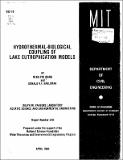Hydrothermal-biological Coupling of Lake Eutrophication Models
Author(s)
Wang, Ming-Pin; Harleman, Donald R. F.
Download10782568.pdf (14.87Mb)
Metadata
Show full item recordAbstract
A deterministic model capable of simulating lake response to changes in hydrologic conditions or nutrient input has been developed. This model may provide a convenient means of evaluating management strategies and identifying weak points in our current knowledge. The emphasis of this model development is to minimize the number of calibrated parameters. A summary of the state-of-the-art of hydrothermal modeling in a phosphorus limited condition is presented in this work. It is demonstrated that a mixed layer hydrothermal model, which calculates the daily vertical temperature profile and thickness of the upper fully mixed layer based on the meteorological and hydrological information, is capable of simulating the transport and diffusive process in a stratified lake with a minimum number of calibrated parameters. Since our ability to mathematically represent complex aquatic biological processes is less well developed than our corresponding ability in the geophysical area, field data plays an important role in defining the final biological model structure. Phytoplankton modeling of L227 is used as a case study to illustrate the methodology for arriving at a biological model whose complexity is consistent with the available data. A procedure is indicated for extracting biological rate constants from primary productivity measurement. The extent to which the linked hydrothermal-biological model simulates the phytoplankton dynamics of the following summer is discussed. Finally, the importance of capturing the short term dynamics of the fully mixed layer in the modeling of phytoplankton variation is illustrated by simulation runs. The simulation runs compare phytoplankton predictions of three lake phytoplankton models with different specifications of the daily fully mixed layer depths. Both a surface nutrient input case and an intermediate depth nutrient input case are considered.
Description
Prepared under the support of the National Science Foundation Water Resources and Environmental Engineering Program. CEE-7906125.
Date issued
1982-04Publisher
Cambridge, Mass. : Ralph M. Parsons Laboratory, Aquatic Science and Environmental Engineering, Massachusetts Institute of Technology, Dept. of Civil Engineering
Other identifiers
270
Series/Report no.
R (Massachusetts Institute of Technology. Department of Civil Engineering) ; 82-16.Report (Ralph M. Parsons Laboratory for Water Resources and Hydrodynamics) ; 270.